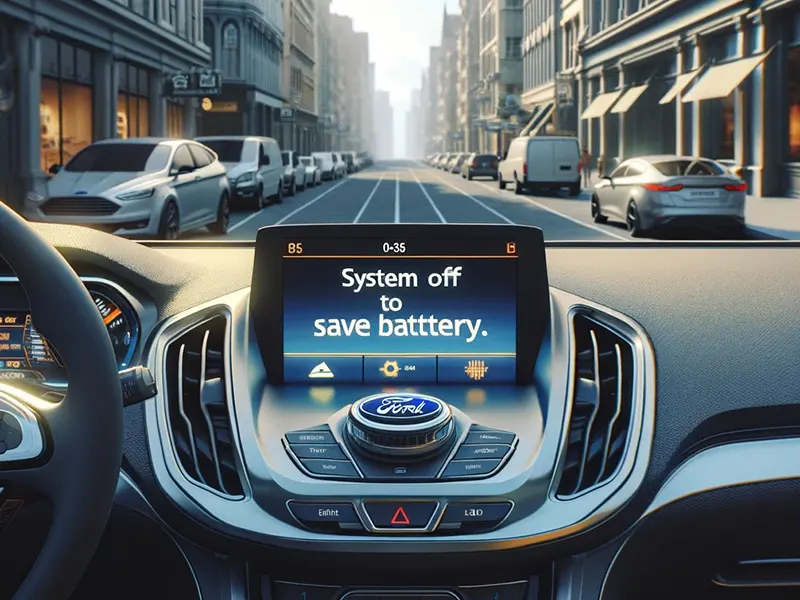The “System Off to Save Battery” warning message in Ford vehicles indicates that the vehicle’s battery voltage has dropped below a certain threshold, causing various systems to shut down to prevent fully draining and damaging the battery. This often occurs when the alternator is not properly charging the battery while driving or there is an excessive electrical load being placed on the battery with the engine off.
Problem Explanation
When the battery voltage drops too low, around 11 volts, Ford’s battery monitoring system will trigger a warning light and message and then systematically shut off non-critical electrical systems.
First, entertainment and climate control features will shut down. If voltage continues dropping, keyless entry and alarm features disable. Eventually, if voltage decreases below 9 volts, the powertrain control module protects itself by shutting down, resulting in the engine not starting. This graduated shutdown prevents damaging the battery through excessive discharge.
Causes of the “System Off to Save Battery” Message
There are several potential root causes for the battery discharging too low and triggering Ford’s battery protection system:
- Low Battery Voltage
- Insufficient Charging: If the alternator is not properly charging the battery while driving, the battery will slowly drain over time from powering vehicle electrical loads. Eventually, this can drop voltage low enough to trigger the warning message. An aging or faulty alternator not supplying 13+ volts may be the culprit.
- Excessive Electrical Load: Using too many electronics in the vehicle with the engine off can overly tax the battery. Extended idling to power climate control, lights, charging devices, and infotainment can drain battery voltage over time. Most alternators cannot supply enough amperage at idle to power all electrical systems indefinitely.
- Short Circuit: Damaged wiring that creates a direct short between positive and negative will quickly drain battery voltage. Even small shorts of a few milliamps can drain the battery over hours or days.
- Parasitic Drain: If components stay active when the vehicle is off due to damaged modules or bad software calibration, they slowly drain the battery over time. Parasitic currents as low as 50mA can drain a battery from full to dead within a week if not addressed.
- Incorrect Battery Calibration
- The battery monitoring control module relies on correct voltage characterization to determine state of charge. If the calibration does not match the true connected battery, low voltage warnings may occur prematurely. Properly calibrating the new battery after replacement restores accurate voltage readings.
- Other Causes
- Intermittent sensor issues, software bugs, or communication errors may also lead to erroneous battery drain warnings in some cases.
Diagnostic Procedures
Diagnosing battery drain issues triggering the System Off message involves multimeter measurements and systematic isolation of fault currents. Required equipment includes a high-quality digital multimeter able to measure DC voltages, resistance, and milliamp currents. Follow these best practices step-by-step:
- Verify charging system operation with alternator load testing and ripple checks during various RPMs.
- Check parasitic drain currents in micro or milliamp range with multimeter while car is fully asleep.
- Inspect wiring harness, fuses, and connections for damage that may cause short circuits.
- Review scan tool data and logged fault codes for modules staying awake or errors.
- Consider updating vehicle software and recalibrating new batteries when installed.
Repair Solutions
To address the root cause triggering the system shutdown message, repairs may include:
- Alternator replacement
- Battery replacement and registration
- Short circuit wiring harness repair
- Software/firmware module update from dealer
- Intermittent electrical issue diagnosis
Ford Mustang Model Years Potentially Impacted
Ford’s intelligent battery monitoring system was introduced around 2010, meaning most Ford vehicles after this year have some version of this feature, including Ford Mustangs from 2010 to 2023 models.
Vehicle Components Potentially Affected
Electrical systems are progressively disabled by the graduated battery protection system trying to avoid fully draining the battery. Entertainment/climate control features first, then keyless entry/alarm, and finally engine management systems.
Cost of Repairing
Depending on root cause, repair costs can vary greatly:
- Alternator replacement: $400-900
- Battery replacement: $100-400
- Wiring harness repair: $100+
- Intermittent electrical diagnosis: $100/hr shop time
Reprogramming or software updates may also be required from an authorized Ford dealership after hardware repairs.

John Smith, a Los Angeles-based car specialist and automotive writer, boasts over 20 years in the industry. With a background as a master technician and a decade-long writing stint at notable automotive publications, John now shares his expansive knowledge on CarFinite, simplifying car maintenance for readers.

